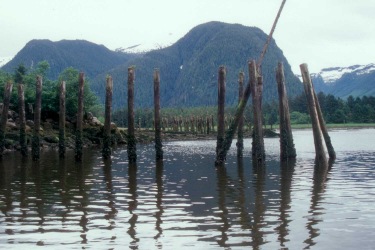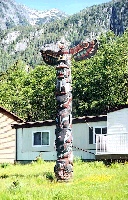
|
|||||||||||
The Big Picture: Relevance of this Project
 These old pilings are reminders of the once-vibrant aboriginal and commercial fisheries in Rivers and Smith inlets. |
This project has the potential for profound value to Canadians. We hope that this project will help determine the causes of the decline in the Rivers and Smith Inlets fish populations. Without this knowledge, remediation attempts will remain as ill-founded as early efforts to deal with impacts of DDT on birds before the phenomenon of bioaccumulation was understood. In addition, the potential role of greenhouse gas emissions in this conservation crisis is a particularly timely issue as Canada comes to terms with its commitments in the Kyoto Accord. The recent collapse of these populations and emerging evidence on the impacts of global warming on Pacific salmon places further urgency on this knowledge. |
Furthermore, at present, we have virtually no direct, scientific information on the marine phase of life for these populations whose smolts have been extraordinarily small. This, along with the impacts of commercial fishing on these sensitive populations, need to be assessed. This assessment is absolutely essential to rational management of these fish stocks, should productivity eventually return. Finally, the recovery of Rivers and Smith inlet sockeye salmon is pivotal to the future for the Owikeno and Gwa’sala First Nations. Not only have the sockeye salmon constituted their most important source of “country food”, but they have also played a central role in their culture. The project has provided limited employment opportunities for adults in the Owikeno and Gwa’sala First Nations through the chartering of the Owikeno seine boat. In addition, we hope to generate opportunities to train youth in some of the scientific tasks associated with the project. Please read on to learn more about the specifics of the project -- return to Rivers Inlet Project Main Page and click on the links at the left-hand side of the page. |
|
